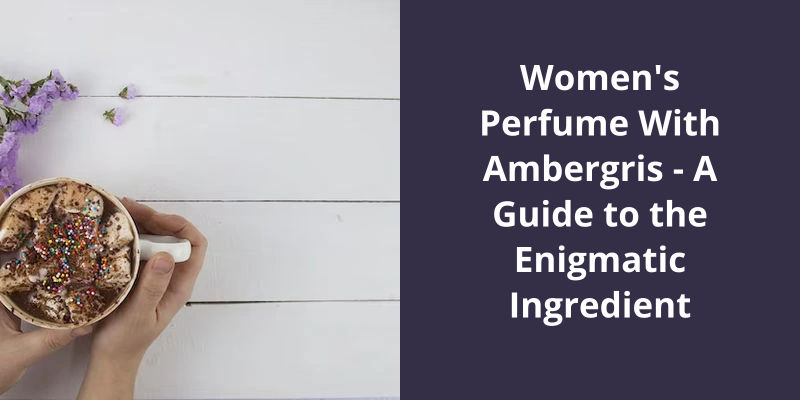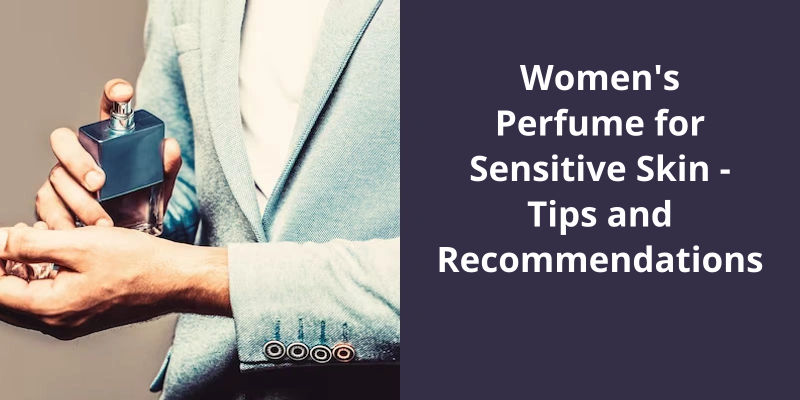Perfumes have been a part of human civilization for thousands of years, with the ancient Egyptians being credited as the first to use fragrances for cosmetic and spiritual purposes. Over the years, the art and science of perfumery have evolved, with new ingredients being discovered and techniques being developed. One such ingredient that’s been used in perfumes for centuries is ambergris, a substance found in the intestines of sperm whales. Despite it’s unusual origin, ambergris has a unique fragrance that’s highly prized in the perfume industry for it’s ability to add depth and complexity to fragrances. In particular, women's perfume with ambergris has become highly sought after, with many perfumers incorporating this ingredient into their creations.

Which Perfumes Still Use Ambergris?
Furthermore, other perfume houses also use ambergris in their signature blends, such as Tom Ford, Kilian, and Byredo. The reason Ambergris is highly sought after in perfumery is it’s unique musky and animalistic scent that gives a warm and long-lasting base to the fragrance. When blended with other notes, it enhances the perfumes overall aroma, making it richer and more complex.
Although ambergris was once harvested from whales, it’s use in cosmetic products and perfumes is now prohibited worldwide. Most of the ambergris used today is found in the sea or washed up on beaches after being naturally expelled by whales as a waste product. The rarity of this material and it’s limited supply make it very expensive, but it’s still used by some of the most prestigious perfume houses worldwide.
Some perfume houses, such as Le Labo, have even created synthetic versions of the ingredient to ensure no animals are harmed in the making of their fragrances.
If youre looking for a perfume that uses natural ambergris, it’s important to research the perfume houses policies on animal welfare and sustainability. Some perfumers source their ambergris in ethical and sustainable ways, while others do not. It’s vital to ensure that the perfume and any of it’s ingredients were made with responsible practices in mind.
It’s rarity, unique scent, and expensive price tag make it a luxurious and sought-after ingredient in the industry. Many perfume houses have switched to synthetic versions for moral and ethical reasons, but there’s still a demand for the natural component.
Aside from perfumes and fragrances, ambergris has found it’s way into the food and drink industry. It’s unique musky aroma has led many to use it as an exotic spice, and it’s been tried and tested in different cuisines around the world. In fact, there are still some places in the world where it’s used as a flavouring agent.
What Products Use Ambergris?
In ancient China, it was used as a seasoning in dishes, often paired with mushrooms or vegetables. In some cultures, it was used to flavor alcohol, particularly brandy and whiskey. However, the use of ambergris in food and drink has been mostly discontinued due to it’s rarity and high cost.
Another product that uses ambergris is traditional medicine. It was believed to have anti-inflammatory and anti-bacterial properties, and to aid in digestion and relieve stomach problems. However, modern medicine hasn’t supported these claims, and the use of ambergris in medicine has largely been abandoned.
Ambergris has also been used in art and decorative items. In the past, it was used to make figurines and carvings, and inlays for furniture and jewelry. Today, it’s still sometimes used in art, particularly in sculptures and other large works. It’s valued for it’s unique texture and iridescent appearance, which is said to resemble the surface of the moon.
Finally, some people believe that ambergris has aphrodisiac properties and use it in perfumes marketed as such. However, there’s no scientific evidence to support this claim. Some people also use it in homeopathic remedies or as an ingredient in natural beauty products. Despite it’s rarity and high cost, ambergris continues to be used in a variety of ways, and it’s complex and elusive scent remains highly prized.
The Controversy and Ethical Concerns Surrounding the Use of Ambergris in Cosmetics and Perfumes
Ambergris is a substance found in the digestive tract of sperm whales and is often used as a fragrant enhancer in high-end perfumes and cosmetics. However, the harvesting of ambergris raises ethical concerns due to the potential harm to whales and the possibility of it being acquired through illegal means. Additionally, there’s controversy over the use of animal products in beauty products, making many consumers uneasy about using these products.
Source: Ambergris – Wikipedia
The unique and complex scent of pure ambergris is truly one-of-a-kind. Comprised of various earthy, oceanic, and even animalistic notes, it creates an unmistakably exotic fragrance blend. But what exactly makes this rare substance so sought after in the perfume industry? Let’s dive deeper into the world of ambergris and it’s fascinating history.
What Does Pure Ambergris Smell Like?
Pure ambergris is a complex and distinctive scent that’s been prized for centuries for it’s unique aroma. The fragrance varies depending on it’s age and location of origin, but the general consensus is that it’s a musky, earthy smell that’s unlike any other scent. However, as the scent settles, it becomes more complex and deeper.
One of the most fascinating aspects of pure ambergris is it’s association with the ocean. The scent is often described as having a salty, sea spray aroma that’s reminiscent of the ocean. This is due to the fact that ambergris is created by the digestive secretions of sperm whales that reside in the ocean, and it’s chemical composition is heavily influenced by the surrounding marine environment. This saltiness is balanced by a sweet, floral note and a hint of tobacco, resulting in a unique and captivating scent.
This earthiness is believed to be the result of the decay of animal and plant matter that’s present in the oceans ecosystem, leaving behind a distinct, musty odor. Interestingly, some people have described the scent of ambergris as being similar to that of wet hay or the odor of the stable floor.
It’s often used as a base note in perfumes and colognes, providing a rich and musky aroma that becomes more appealing over time.
It’s musky, salty, earthy, and mossy aroma is both exotic and captivating, making it a highly sought-after ingredient in the world of perfumery. It’s a scent that becomes more appealing over time, evoking the beauty and mystery of the ocean and the natural world.
The use of rare and exotic ingredients has become a hallmark of high-end perfumery, with each luxury scent boasting unique and memorable fragrance notes. Dior’s Ambre Nuit, for instance, incorporates ambergris from New Zealand as it’s base note, elevating the fragrance to another level of exclusivity. But what exactly is ambergris, and how does it factor into luxury perfume creation? Let’s explore further.
Is Ambergris in Dior Perfume?
Ambergris has been used in perfumery for centuries, and it’s unique scent is often described as musky, earthy, and slightly sweet. It’s a waxy substance that’s produced in the digestive system of sperm whales, and it’s typically found as a floating mass in the ocean.
Diors Ambre Nuit is one of the brands most popular fragrances, and it features ambergris from New Zealand as it’s base note. The fragrance is designed to evoke feelings of sensuality and elegance, and it’s a warm, intoxicating scent that lingers on the skin for hours.
In traditional Chinese medicine, it’s believed to have anti-inflammatory and anti-viral properties, and it’s been used to treat a variety of ailments including fever, coughs, and colds. In the culinary world, ambergris has been used as a flavoring agent in dishes such as custards and ice cream, and it’s sometimes referred to as the “king of spices.”
Although ambergris is a highly prized ingredient in perfumery, it’s use has been controversial due to concerns about it’s sourcing. Sperm whales, which produce the substance, are protected under international law, and the hunting of these creatures is illegal in many countries. However, ambergris can still be found in the wild, and it’s sometimes washed up on beaches where it can be collected and sold.
The History of Ambergris in Perfumery: When and How Did People Start Using Ambergris in Fragrances, and How Has It’s Use Evolved Over Time? What Are Some Other Popular Perfumes That Feature Ambergris as a Note?
- Ambergris has been used in perfumery since ancient times, with the ancient Egyptians being known to use it in their perfume formulas
- During the Middle Ages, ambergris was highly prized in Europe, and it was considered a luxury item
- In the 18th and 19th centuries, ambergris became more widely available and it’s use in perfumery became more common
- Today, ambergris is still used in many high-end perfumes, and it’s unique scent is highly prized by many perfumers
- Some popular perfumes that feature ambergris as a note include Chanel No. 5, Tom Ford’s Amber Absolute, and Creed’s Aventus
As the use of ambergris became more controversial and unsustainable, a viable alternative was sought after. This came in the form of ambroxan, a compound that closely replicates the unique fragrance of natural ambergris. Widely used in the perfume industry, ambroxan serves as a suitable replacement and is derived from naturally occurring terpenoids.
What Replaced Ambergris?
Ambroxan is a synthetic version of ambergris that’s been developed to mimic the unique scent properties of the natural substance. This compound is used extensively in the fragrance industry to add a subtle musky note to perfumes and other scented products. This has made it a popular choice among perfumers and fragrance manufacturers worldwide.
In addition to it’s use in perfumery, ambroxan is also used in a variety of other applications. It’s commonly found in cosmetics, soaps, and other personal care products, where it’s used as a fragrance enhancer and fixative. It’s also used in food flavorings and as an ingredient in some pharmaceutical preparations. Despite it’s widespread use, however, ambroxan remains a controversial substance, with some critics questioning it’s safety and potential health risks.
One of the main concerns about ambroxan is that it may trigger allergic reactions in some people. This is because the compound has been shown to interact with the bodys immune system, potentially leading to allergic responses. Some studies have also suggested that prolonged exposure to ambroxan may be linked to increased risk of certain types of cancer.
Advances in technology and manufacturing processes have made it possible to produce larger quantities of the compound at lower cost, which has helped to increase it’s popularity and availability.
The History and Cultural Significance of Ambergris in the Fragrance Industry
Ambergris is a waxy substance that’s found in the digestive systems of sperm whales. It’s been used in the fragrance industry for centuries due to it’s unique scent and fixative properties. It’s cultural significance is rooted in it’s rarity and historical association with wealth and luxury. However, it’s use has been controversial due to concerns over the welfare of sperm whales.
Now that we’ve learned about the various scent notes that make up Chanel No. 5, it’s interesting to explore the use of these ingredients in the perfume industry and how they affect our senses. From the fresh burst of citrus to the deep warmth of amber, each note plays an important role in creating the iconic fragrance loved by millions around the world.
What Are the Smells in Chanel No. 5?
Chanel No. 5 is a classic fragrance that’s been a trendsetter in the perfume market since it’s introduction in 192This iconic scent boasts a unique and sophisticated blend of ingredients that’s a long-lasting and memorable effect on those who wear it. The fragrance is known for it’s rich and floral composition that’s both timeless and modern.
The middle notes of Chanel No. 5 are iris, jasmine, rose, orris root, and lily of the valley. These floral ingredients create a warm and romantic scent that’s soft and gentle on the skin. Iris in the perfume provides a powdery and woody smell, while jasmine adds a sweet and exotic touch. The rose flower creates a light and romantic scent, while orris root gives a slightly spicy smell.
These ingredients form the enduring scent that lingers on the skin long after the top and middle notes have faded. The vanilla gives the perfume a sweet and comforting smell, while sandalwood and patchouli add a woody and earthy aroma. Musk and amber provide a warm and sensual feeling that creates a deep and mysterious scent.
The top notes of aldehydes, ylang-ylang, neroli, bergamot, and lemon, combined with the middle notes of iris, jasmine, rose, orris root, and lily of the valley, create a perfect balance that’s both soft and gentle on the skin. The base notes of civet, sandalwood, amber, musk, moss, vetiver, vanilla, and patchouli form an enduring scent that lingers on the skin long after the initial application. All these elements combine to create a fragrance that’s classic, sophisticated, and unforgettable.
The Role of Marketing and Advertising in Establishing Chanel No. 5 as an Iconic Fragrance.
- Chanel No. 5 was created in 1921 by Gabrielle “Coco” Chanel and renowned perfumer Ernest Beaux.
- Marketing played a key role in establishing Chanel No. 5 as an iconic fragrance.
- The fragrance was marketed as a luxury item, with beautiful packaging and high-end pricing.
- Celebrity endorsements from Marilyn Monroe and other famous figures also helped to solidify Chanel No. 5’s status as a must-have product.
- Advertising campaigns featured beautiful images and elegant language, appealing to women’s desires for sophistication and glamour.
- Today, Chanel No. 5 continues to be a top-selling and highly sought-after fragrance.
Conclusion
It’s unique scent profile offers a complexity and depth that’s highly sought after by perfumers and consumers alike. The use of this rare and precious ingredient is a testament to the artistry and expertise required to create truly exceptional perfumes.




